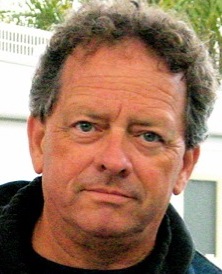The Windhook Interview—David Limrite
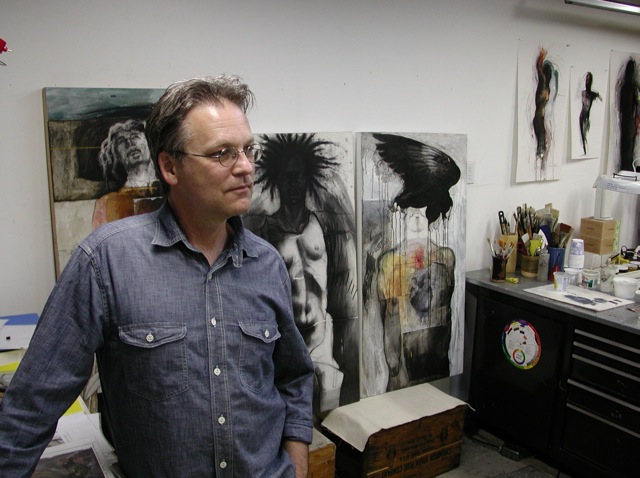
One weekend in the Fall of 2010, we were buzzing around the Open Studios circuit in the north part of San Luis Obispo. We had cherrypicked half a dozen or so artist studios that looked interesting to us from the catalog, and plotted our path around the county to find them all. After the first couple of places we began to notice that this particular couple was at each studio at the same time that we were. The second time we encountered them, we made small talk about the coincidence. But when we found them at the third place, in a different town, a half hour drive from where we encountered them before, we decided the universe was talking, and introduced ourselves. They were David Limrite and Jordan Blaquera. This remarkable couple are the Director of Education, and Administrative Director for the Brentwood Art Center, in Los Angeles. They had driven up the coast for the weekend, specifically to check out the local Open Studio Tour. They had chosen the exact same hand full of studios that we had, from a huge list in the catalog. They had gone to these studios in the same sequence and timing that we did. We have stayed in touch ever since, and now we present you with our interview with David. It's a lively interview, and we didn't do much to trim the edges. The banter at the beginning was from before we actually started the interview but after the recorder started.
Michael: Ok, we've got 38 hours and 39 minutes available on the digital recorder. [Laughter]
David: You cleared it out for me. Let's go! We've got a lot to say.
Michael: Yeah.
David: We'll have to take a break for lunch.
Michael: We've prepared a set of canned questions in case things go quiet.
Peggy: Well, we don't want to go back and listen to this later and realize we forgot to ask something.
David: How many of these have you done?
Michael: Let's see. We started in October.
David: So one a month since then.
Peggy: Yes.
Michael: We're starting to get a little bit of a portfolio of interviews now. And it's a lot of fun. In fact, the one from this morning [this was recorded July 1] was an artist in Ottawa, Canada. We did it on Skype. We got interested in her because she does life drawing modeling...
David: Ohh!
Michael: ...and photography modeling, as a sideline.
Peggy: So it's both sides. Modeling and art.
Michael: Originally we were going to interview her about the modeling as part of an article, but she was interesting, and we decided to do a full interview. And out of that, she's probably going to write an article for us. A guest writer. She's really a good writer on top of everything else.
David: I did a photo shoot yesterday for my web site and the model we used—young, came to LA from Berkeley at 17, wanted to be an actress, decided that wasn't for her—she's an art history major now at UCLA. She models, and it's just fascinating how people get to where they are. It's just amazing how people end up where they end up—which is the great thing about these interviews.
Peggy: That's it. How did you get to where you are?
Michael: Yes. Let's start with that. Tell us a little about your background, your history, where you came from, where you grew up...
David: Ok. I grew up in Salinas, California, which is central California. My mom is still there. My sister and her husband and kids are still there, so I get to go up often. My dad just passed away this year, so that was a bit of a shock. I went to high school and two years of community college there.
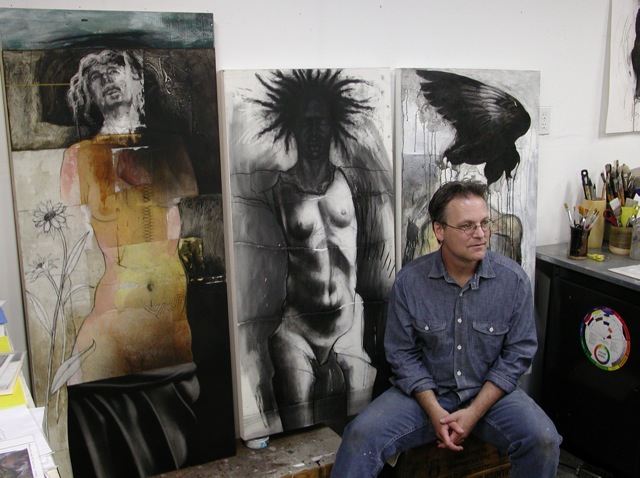
Peggy: At Hartnell?
David: At Hartnell. I got involved in the theater department there. I did art in high school, and did side projects. I was the high school artist. Any time they needed something, there I was. It was fun. It was my ticket into all the different groups of kids. A friend of mine was an actor in the theater department at Hartnell, and he came to me one day and said that they were behind the gun on an upcoming production and needed some help painting sets. So I helped with that and loved it! It just got me going. So I stayed there for probably an extra year. They let me design sets and costumes and lighting. I blossomed there. I think it's where I started to take off. The thing that I really loved about it was working with all the people. I loved the collaboration. It was great—egos and everything. Even actors in junior college still have egos.
[Laughter] But the thing that I really loved about it was taking an empty space and doing something with it. Making something out of nothing.
I didn't really think about it in terms of art making then. They had a proscenium stage and also what they call a black box and I got to design in both of those spaces. It was great—to go in there and have this empty space and just do it!
Peggy: And you had never done it before.
David: Never done it before! I just found my element. So I loved that. A great experience. Did a lot of growing up. They gave me a lot of responsibility. And it worked out great.
And then I went to San Diego State University to finish my college. I went in thinking that I was going to be a theater set design major. But somewhere along the way, I realized that in order for me to communicate my ideas to directors and to costume designers, I had to be a better artist. So I decided to go in as an art major, and do some theater on the side. Well, the theater never happened. They had just built a brand new art department and there was one teacher there who took me under his wing. I had gotten most of my general requirements out of the way already, so for two years, I could just paint and draw and take art history classes. I just immersed myself in it. So I got a taste for art making.
Peggy: Yeah!
David: This was in the late seventies, and in the seventies, art instruction was very conceptual. I don't even think I had a figure drawing class. So when I graduated, I thought, "You know, I don't think I really quite have it yet. I really would like to learn how to draw better."
I went back and worked at the Hartnell theater for the Summer, because I didn't know what I was going to do, and ended up getting accepted at Art Center in Pasadena. I went there and asked, "Where am I best going to learn how to draw?" They said the best place to do that was as an illustration major. I didn't really know what illustration was. I didn't have a clue. But I went through their illustration program. So I went in there and immersed myself in their drawing program and learned how to draw really well.
So, I graduated from Art Center. This was in the early eighties. I got a job at the Los Angeles Herald Examiner, which was a newspaper here at the time. I got a job there in the art department—was in the right place at the right time. It was a great job. I worked my way up to art directing the food, travel, and lifestyle pages and things like that. What was great about the newspaper was that it was something different every day. You walked in and you didn't know what you were going to do. The news dictated. And because of my Art Center experience, not only could I draw really well, I could draw really fast. So that really helped in the newspaper game.
During the newspaper time I started exhibiting my work, getting work accepted in shows, and got a gallery. Then the paper folded in 1988. That was an interesting experience—you walk into work and the LA Times reporters are there already.
Peggy: That must have been awful.
David: I'll never forget it. You walk in and all these Times guys are there. And you ask, "What's going on?" and they say, "We heard something's up." So management called us all in to the main news room and said, "Today's your last day."
Peggy: Oh my god! It was really...
David: Yeah, so they kept a few of us on for a couple of weeks to clean things up. I stayed on to clean out the art department, but that was an interesting experience.
I worked for a muralist for a while, which was an interesting thing, taking it to that large scale.
Peggy: So you painted the muralist's designs?
David: Yeah, we worked together. He was a single guy, just a one person business. I was living downtown at the Brewery at the time. Jordan and I were living there. And he needed some help, and I was out of a job all of a sudden. I worked for him for maybe a year. It was interesting. We did some church stuff, and a hot springs thing, some restaurant stuff. It was a job. Not something I really aspired to do.
In the mean time, we were at the brewery, and Jordan and I were some of the founding members of what is now the Brewery Art Walk.
Peggy: Really!?
David: Yeah, They had started getting it going a little bit, but they needed some leadership and direction.
Peggy: We've always meant to go there.
David: Now it's huge. When we lived there you sort of felt like you were doing it illegally. It was legal, but it was only a couple of buildings, and it was mostly artists, and it was still fairly quiet.
Peggy: How many people were living there?
David: At the time, maybe eighty. It was still a good size, but now there are hundreds. They've opened up more buildings.
Peggy: It's huge now.
David: We helped them get that art walk thing going. That was kind of fun. But we got tired of living downtown. It was romantic for a while. We had a 2000 square foot space with twenty two foot high ceilings, and it was great, and it was romantic, and it was the idea of living in a loft downtown, but tough living. Hard living.
Michael: How so?
David: Well, just getting modern conveniences. Just going to the grocery store.
Peggy: Yeah, I was wondering about that.
David: We came into Glendale to get groceries. And it's not in a very nice part of town, so at times you're stepping over people to get to your front door. Concrete everywhere. Train station right there. It's right there on the 5, and across the freeway is the USC Medical Center, and...

Peggy: Ambulances
David: That, and also, people escaping. [laughter] You'd see guys walking down the street with a hospital gown on, tush to the wind, with their bracelet...
Peggy: My friend's first day on the job there, somebody dropped off a dead body in the parking lot.
David: And gangs. So anyway, all that's part of what made it hard. But at the same time, it was the romantic ideal of the artist in the loft.
Michael: Well, everybody knows about it...
David: It's an incredible place!
Michael: And the model for a lot of similar experiments around the country.
David: So anyway, about that time, another artist who was living at the Brewery, was teaching at the Brentwood Art Center. And he said, "I'm moving, and I have to leave my position at Brentwood. Would you be interested in taking over my class?" I always wanted to teach. But I had no experience teaching. So I sent in my resume, and the director of the school called me back and said, "I'm sorry. You're probably a really great guy, but you don't have any experience."
So, a week or so later, I get another call from him, and he says that a woman that takes classes at the school who heard that I had applied—she was a client of mine. I had done several pieces for her and her husband, and I had done a portrait of her—and she had come to him and said, "This guy is awesome. If you don't hire him, you're a fool!"
Peggy: Wow!
Michael: That's amazing!
David: Isn't that unbelievable?
So he called me in and interviewed me, and gave me the class. He said, "I never give people a chance that don't have teaching experience, but I'm going to give it a try." So he worked with me a little bit, and he's a very good educator and an interesting guy, and has a huge history in teaching.
Peggy: What's his name?
David: Ed Buttwinick. He and his wife, Linda, started this school. He was a public school teacher, and an artist, and at one point, he got tired of the red tape in the public school system—this was in the sixties—dropped out, started teaching classes out of a friend's garage in Westwood, and within weeks, he had ninety students, and the guy that owned the house and garage came to him and said, "I can't do this. It's too many people." So they found this building over on 26th and Montana, and they've been there ever since.
Peggy: We go by it all the time.
David: Forty years, the school's been there. I've been teaching there for twenty two years. So in the mean time, I had been sending out my resume, and thinking, "I can do this teaching thing." So I thought I should go back to my alma mater, Art Center, and see if I could teach there. I sent my resume to the person who was the foundations department chair, and she wasn't having it. She wasn't interested in me. But another guy, who was a teacher of mine way back when, became the foundations department chair, and was going through her records one day, and said, "I saw these letters from you. I didn't know you wanted to teach. Come in. Let's talk."
Peggy: Wow!
David: So I went to Art Center. He gave me a job. So I became a full time instructor and taught three classes. That's full time.
Michael: This is very interesting. You have two stories of being turned down outright.
David: Yes!
Peggy: And just the one advocate in each case turned it around.
David: Exactly! I had an advocate each time.
Michael: There's a lesson in that.
David: Don't give up. Perseverance. Don't burn bridges. [Laughter] Gain advocates as you go along.
Peggy: Be nice to people because you don't know who's going to help you down the line.
Michael: And that is so true.
David: The woman that went to bat for me at Brentwood—I'm still friends with her to this day, and I even gave her some free classes for doing it.
So, eight years ago, the founders retired, and a new gentleman bought the school, and they came to me and Jordan and said, "Would you guys be interested in running it? If I buy it, you guys run it." So we've been doing that for eight years now. I do the education part, Jordan does the administration part.
Michael: How long have you guys been together?
David: We've been together for 27 years. We met at the Herald Examiner. I was in the art department and Jordan came in as a temp.
Peggy: Is art her background, or admin?
David: When we met she was a musician. She had a rock band. She decided not to go that way. She got into theater for a while, but she's incredibly smart, and she can step into a situation and just make it go. Currently she's a life coach in addition to working at the Brentwood Art Center.
Michael: It sounds like you have a pretty good dynamic between you around your art.
David: We do.

Michael: That's something we always like to talk to people about—how you mesh your art with your personal life. Because you can't really separate them.
David: And we work together. So we're around each other 24 hours a day. People always tell us, " I could never work with my spouse." But you guys have a similar thing too.
Peggy: We do.
David: Yeah, so we have that in common. Jordan and I worked on the Brewery project together, I helped her with her band, she helps me with my art career and we run the Brentwood Art Center together. We've always worked together.
And what comes to mind when you bring that up is that one of the defining moments for us was when we were living at the Brewery, and we were in the loft. You live in it and you work in it. So I had one section, and we had an office for her, and there was a little upstairs, but its all together. So I'm working on some large scale charcoal drawings, and one day she came up and just started giving me her input. And I got upset. I didn't mean to, but I did. It was unsolicited. So we had to sit down, work it out, and make some rules.
Peggy: Boundaries.
David: Yeah. She has a good eye, and I trust and respect that. I said, "I would love your feedback, but when I ask for it." She understood. She got it. I think that in terms of this working relationship, this was a defining moment. It's never been an issue since.
It's a little different now, because I've got this space out here that's separate. But I will definitely bring her out here when I want her feedback. And she's very straightforward about it. Many times, she doesn't like what I'm creating. We've had discussions about that too. She came to me a while back kind of upset one day, and she said, "I feel really bad. I don't really like what you're doing." And it was a big deal for her to say that. It was a very emotional discussion. I told her that it was OK. That was a huge release, because I think she expected me to take it personally. So I think that was another defining moment, and that wasn't that long ago.
You guys know, you can't put it on cruise control. You've got to keep working on it.
Peggy: I have one question, backing up, way back. When you went to Art Center, did you work? I mean Art Center is not cheap.
David: Yes, I did work. I got a job on campus. And my parents helped a little bit, and I took out loans, which took me ten years to pay off. But when I look back, I graduated in '83—way cheaper than it is now.
Michael: It seems like the teaching has really been the enabler to let you stay focused on your art rather than going off to get a job at IBM or someplace.
David: Right. You know, I'm lucky. That's been the great thing. And, I've been teaching for 22 years now, and I've become a good teacher, and I enjoy it. It fuels me.
Michael: There's another side to that. A lot of people—and I'm this way—find it difficult to mesh their art with their money making career when it's not purely their art.
We've talked to people who taught, and felt that it distracted them from having the time and focus to work on their own art. And they have felt that only when they retired or were able to break away from it for awhile were they able to really focus and spend the energy and time on their own work. Have you felt that struggle?
David: Yes! Very much so. But I always manage to make my work. Many times I'm depleted, many times I come home exhausted. But I sneak it in there somehow.
Peggy: Do you keep a routine? I mean you have a long commute.
David: We do have a long commute.
Michael: You get to carpool though.
David: We get to carpool! The 405 is a mess right now. All that stuff they're doing. Now they've started to close off ramps and onramps, and they've closed Wilshire. Crazy! That's going to go on for a year. so we do a lot of business in the car. We get a lot done. Talk things out about school.
Routine? No. I don't find that I can have a routine. I wish I could but I don't. I keep saying that I'm going to have a routine. I would love to be one of those people that get up at five in the morning and make my work. I'm not there yet. I'd love to do that. And I can't stay up as late as I used to.
Peggy: [Laughing] We've all noticed that. Or then you're lost the next day if you do.
David: Right. So I know where my pockets of time are, and I try to take advantage of those. We don't get home until late, sometimes eight o'clock. Sometimes I'll have enough energy and I'll come out into the studio. And here's the thing if you can make yourself do it. I will force myself to come out into the studio, but once I'm out here, and I get going, three hours can go by like that. And you get energized again.
Michael: Yes.
David: So I have to keep telling myself that too. If I can just make myself show up...
Michael: This space is totally dedicated to your art. There's nothing else going on in here.
David: Well, my bikes. I've got a couple of bikes in here.
Michael: Ok, you park your bikes in here.
David: Yeah, but that's it.

Michael: But really there's no other purpose for this space. When you walk in the door, there's nothing really in the way.
David: You're exactly right. And I think that's important. I talk to so many artists, who don't have a dedicated space—they're doing their work on the dining room table, and they've got to clean up afterward. I think that's a big deal. I think you make a very important point.
Michael: Well, it's personal experience.
David: And I get that. I understand it. The other thing is that I always try to have something in process. The toughest time is when you've done a bunch of work, for a show, let's say. And everything is out at the show, and all you've got back in the studio is blank canvases. That's death. So years ago, somebody told me, "Keep one piece back that is not finished, so that when your work goes out to the gallery, there's always something that you can come right back and jump in on."
Michael: That's a good one!
David: Yeah. I like that, and I've been using it ever since. But I always try to have something in process, even if it's small. And that's another interesting thing. I always used to work big. Life size. There's some life size stuff in here now. Lately, I've begun making some smaller pieces. And I've found that if I'm too tired to tackle something big, I can come in here and sit and work on something small. It's not such a drain. Not such a big deal.
The older I become, the more art I make, the more the process becomes mental. Keeping it going, battling the day-to-day stuff—making art in the middle of things.
Michael: I like it.
David: Yeah, isn't that good? Being able to step away, enter your art zone, your temple, whatever you want to call it, and leave the dishes in the sink, whatever it is, and being able to make art in the middle of things.
Peggy: That is good.
David: It's a big, big thing. I talk to my students about that kind of stuff all the time.
Michael: So you're running Brentwood. I assume you're not still at Art Center. How long were you there?
David: No, I was at Art Center for 12 years.
Michael: Concurrently.
David: Yes, I was working at both places at the same time. I started at Brentwood first.
Michael: So I'm guessing that when you took the leadership position at Brentwood you dropped Art Center.
David: Yeah. It was a tough decision. It took me almost a year to decide.
Peggy: And it was close.
David: And it was close! Didn't even have to get on the freeway to get there. But there were some changes going on there too that I wasn't really liking. They were starting to do some things and make some decisions about classes and about things to be offered in the future that didn't seem right to me. So that helped me to make the decision, and I don't miss it. I miss some of the teachers. There were some really great teachers there, and I miss them. But I moved forward.
Peggy: At Brentwood, it's all ages?
David: All ages. We start at four years old and our oldest student now is 91. And for summer, we do a gigantic day camp program for kids. The other thing I've been doing in the mean time is training to become a creativity coach.
Michael: Tell us about that.
David: I've been training for a couple of years now.
Michael: By training, what do you mean? How do you train for that?
David: Taking classes, reading and writing a lot, and practicing coaching actual clients, for free of course. The classes you take, you are assigned to people, and you actually coach them.
Peggy: Who's offering those classes.
David: There's a creativity coaching association. There's a gentleman named Eric Maisel, who is probably the father of creativity coaching. He's written over 30 books. I've taken some online classes from him. However, I think I've been training for 22 years in my teaching to become a coach. I read a book about it, and everything I was reading in the book, I thought, "Oh my god! I say that in my classes."
Peggy: What's the name of the book?
David: It's called "Inspiring Creativity." It's an anthology of about 20 essays from different coaches about their experiences. And I realized that they were talking about me. This is what I do. I say this stuff.
Michael: We may need to have a different discussion about this.
David: I'm going to focus exclusively on coaching visual artists, because that's what I know. What I want to do is help artists be better artists. I want to help them manage their mind while they're making art.
Peggy: That's huge.
David: I have been rejected from more galleries than you can count. You guys know. I have been dropped from galleries because I didn't sell enough work. So I've been there. I know what that does to the spirit. I know what that does to the heart. I've also been through six month blockages in my work. So I've developed a lot of tools to break myself out of that. So I can help people be in their studios, manage their mind, show up, and make their art. Help them if they hit a wall. Help them if they spend a year making a group of work and it goes to a gallery and they sell nothing. That's what I want to do. I think there's a need for that out there.
Michael: I think that's a very understated comment. [David laughs.]
Peggy: People in the art community are starving for that.
David: I think they are. Even just in my students at school. And the people I got assigned to work with in the classes. I worked with a painter, I worked with a musician, I worked with a landscape designer. They all have the same issues. They came at it from different ways, but they all had feelings of being lost, of not knowing what to do, not knowing what to focus on, too many ideas. I can't tell you how many artists have too many ideas, and don't know where to go. Don't know how to pick the one that is the most meaningful to them, and start. So one day it just clicked for me. I think I can take my teaching to the next level, and help people with what I have learned.
Peggy: And you have such great energy about it, so I think people would respond really well.
David: Yeah, I think so too.
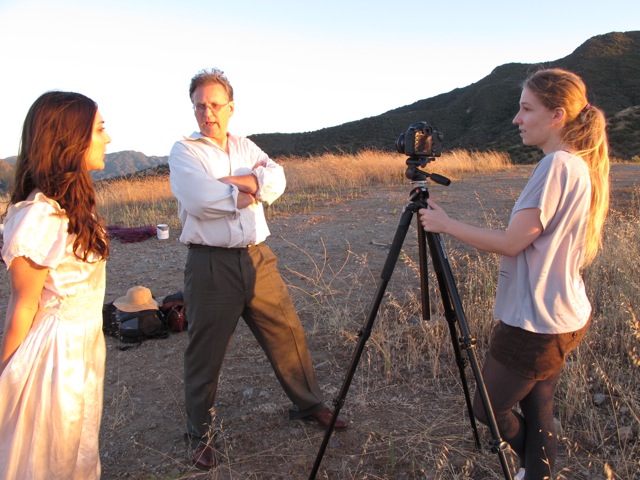
Yesterday I did this photo shoot with this amazing photographer. Her name is Brooke Shaden. Amazing. 24 years old, but my god! She's unbelievable. She taught for me for one semester. She does workshops all over the world. She's getting ready to go to London and Berlin. Anyway, I wanted to have a photograph that illustrated this idea of going for it. Of dreaming big. Of sky's the limit.
So I took this stick [points up to a stick hanging on the wall] and tied a paint brush to the end of it. I'm out in this field overlooking a mountain, and there's a model (the muse,) and she's dressed in a white dress, and she's got purple fabric blowing in the wind, and I've got paint cans all around me, and I'm painting in the sky. So we shot this last night, and she's going to photoshop the hell out of it, with a stormy sky and all this kind of stuff. This is the kind of thing I want to do. I think this photograph is going to be on the coaching page of my new website to illustrate this idea that the sky's the limit. Dream big. Go for it. Can’t wait to see the finished photograph. Brooke is in Europe now so it won’t be ready for a while. 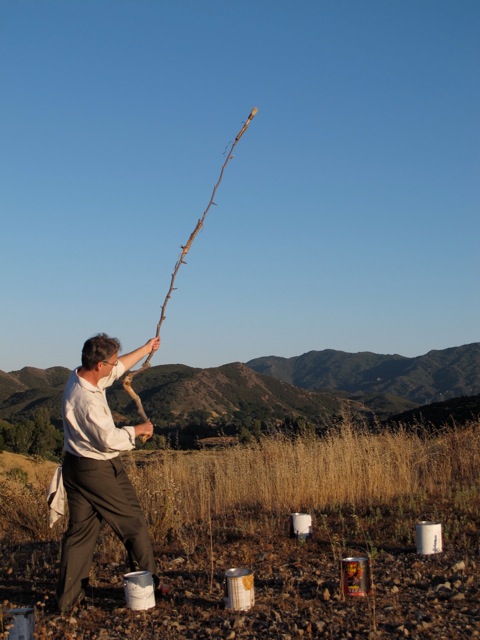 I will let you know when my new site is launched. Work on the new website slowed down a bit when my dad died a couple of months ago, but it's picking up again now. Should be ready to launch in September.
I will let you know when my new site is launched. Work on the new website slowed down a bit when my dad died a couple of months ago, but it's picking up again now. Should be ready to launch in September.
Peggy: Speaking of your dad, were there artists in your family?
David: There were not. But I think my dad had an interest in it. He played the French horn in the Navy band. My sister got the music talent. But when I started showing an interest in it, my parents never questioned it, never tried to talk me out of it. I remember my dad giving me cartoon books to draw from. They encouraged me to color outside the lines in coloring books when I was little.
Michael: So you never got the message that we think you are a good artist and we like what you do but you need to go find a real job.
David: No. I never did.
Michael: That's huge.
David: It is. And I've thought a lot about that, especially since he passed. I've been very lucky. I kept going to art schools, and they never once questioned that. They helped when they could. My dad worked for a bank all his life. A desk job. My mom was a secretary pretty much all her life. My dad said to me one time, "If you can make a living doing something with your hands, that's what I want for you."
Michael: Sounds like he knew you.
David: I think so.
Michael: He was your dad.
Peggy: But that doesn't always happen.
Michael: Not all dads have that sensitivity.
David: No. Not at all. So I was very thankful for that. Until the day he died, he was very supportive. He came to as many shows as he could. I was showing in Sacramento for a while and he came to a lot of shows up there.
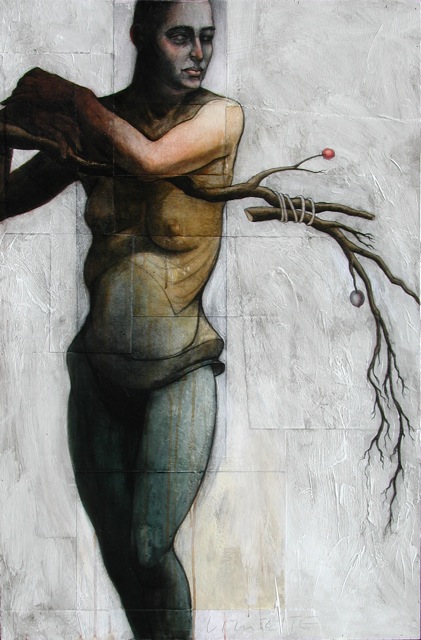 I don't really know how much they appreciated my work. They were always pretty conservative. But they had some odd things of mine hanging in their house, which always surprised me a little bit. We never talked about the subject matter. The one thing they had in their house is a piece called Grafter. It's a nude woman. I borrowed the pose from a Paul Prud'hon painting, she's leaning on a branch and the branch is tied together with two different pieces of fruit on the two parts of the branch. I remember that my dad's dad was an inventor of sorts, and he was always making stuff. He had this place. It was his garage, but when I was a kid, it was a laboratory to me. He was a fisherman and he tied his own flies, so there were always feathers and fur hanging, and he was always heating and pouring lead, and we'd make kites out of newspapers and sticks and rags for the tail. So that was pretty cool. And one day, my dad and my grandfather decided they were going to graft a lime tree onto a lemon tree. It never worked. So that's why I did this piece, and my dad got the biggest kick out of it. And that's the piece they've had in their house for all these years.
I don't really know how much they appreciated my work. They were always pretty conservative. But they had some odd things of mine hanging in their house, which always surprised me a little bit. We never talked about the subject matter. The one thing they had in their house is a piece called Grafter. It's a nude woman. I borrowed the pose from a Paul Prud'hon painting, she's leaning on a branch and the branch is tied together with two different pieces of fruit on the two parts of the branch. I remember that my dad's dad was an inventor of sorts, and he was always making stuff. He had this place. It was his garage, but when I was a kid, it was a laboratory to me. He was a fisherman and he tied his own flies, so there were always feathers and fur hanging, and he was always heating and pouring lead, and we'd make kites out of newspapers and sticks and rags for the tail. So that was pretty cool. And one day, my dad and my grandfather decided they were going to graft a lime tree onto a lemon tree. It never worked. So that's why I did this piece, and my dad got the biggest kick out of it. And that's the piece they've had in their house for all these years.
Michael: With all you've said, I'm a little surprised that you don't have a more three dimensional aspect to your work.
David: That's a great point.
Michael: I'm not suggesting that you should but it surprises me that I don't see more of it.
David: I can tell you a couple of things. I think I have my hands full with the two dimensional thing. [Laughs] I don't think I've mastered that yet. But I have begun to glue rulers and three dimensional objects on some of my newer pieces[points to a piece on an easel], and this piece [points to another) And there's this piece and this piece, and there are going to be hooks with metal things hanging down.
Peggy: An armature.

David: Yeah, so I'm starting. So it's interesting that you bring that up. The other thing I've done too, is that I'm starting to glue canvases together. I did this whole series of mermaids, but I call them sirens because they're more dangerous and more sexy than the Disney mermaid. I started using this [the seam between the panels] as the subtle demarcation between the human part and the tail. This was a series of about twenty pieces that I put in the gallery in Laguna, and didn't sell a single piece. They have since dropped me because I wasn't selling enough work for them. The gallery owner told me a story. I love stories like this. Some artists might be devastated by it but I get a kick out of it. These two guys came in, and they both picked out one of these big sirens that they liked. They lived together, and they each picked out one they loved. So the gallery owner took the pieces over to their house so they could see them in their space. While they were there, their girlfriends came over, and the girl friends said, "No. Not having those in the house." Killed the sale right there. I don't know if they just didn't like them or if they were threatened by them. They're a little sexy, a little edgy. But that killed the sale.
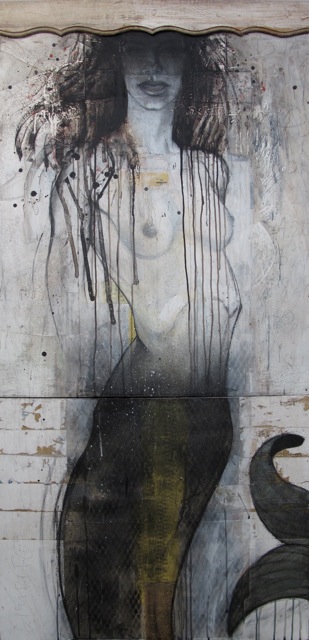
Michael: They're a little dark.
David: That's right. They're a little dark. But all my work is a little dark.
Michael: I think it has to be—and I love it.
David: Thank you. I love doing it. You know, I have an upbeat, bubbly personality, and all the time people say, "You did that? You make all that dark work?"
Michael: You made a comment in your artist's statement...
David: Yes!
Michael: ...about the fact that you put darkness into your work because it doesn't show up anywhere else in your life. That's a very interesting comment.
David: I've had a pretty idyllic growing up situation. My parents were married for 55 years. Not many troubles—just minor stuff. The inspiration wasn't coming from that kind of stuff.
Michael: I relate to this story very well. I grew up in a very stable middle class conservative family where everything was fine. I think that's why this comment resonated for me.
David: My artwork is for me first, and everybody else second. And if there's not something juicy in it for me, there's no way.

I kept looking around at other artists and thinking, "Where are they getting that from?" And I'd talk to them and they'd say, "Oh yeah, I had this tragic thing, and it was horrible, and the art came out of that." And I'm over here and I've got nothing! So another thing that helped me with that was working at the newspaper. I was exposed to so much negative news. So much tragedy. I was working at the newspaper when the shuttle exploded. That was unbelievable. I'll never forget that. And the photography that would come in. A lot of it was black and white. I think that was one thing. Another thing that got me going was the set design thing. I was drawn to the darker stuff. Tennessee Williams. I designed a set for Glass Menagerie and it was dark and it was heavy. And in the middle of that was the lighted table with all the little glass animals. But the whole rest of the set was dark. So I think I was drawn to that.
Michael: Another thing that occurred to me as you were talking about set design is the similarity between set design and installations.
David: Very much so, and I think I could probably very easily get into that. But it just seems beyond me. It just seems out there. Like I wouldn't know where to go or what to do. You would think I would though.
I love to go see them, and I love it. But for now, I've got all I can handle.
Michael: Well, let's tie this back. A minute ago you were talking about coaching, and in fact one of the things people have trouble with is narrowing their focus.
David: That's right.
Michael: So I 'm branching out, thinking of all the different directions you could be going, but you have successfully narrowed it down. So don't pay any attention to any of this.
David: [Laughing] Believe me. I would love to try some of it. And if at some point I am not directing the Brentwood Art Center, and have more time on my hands, I will definitely experiment with other forms.
Peggy: Do you work on one piece at a time?
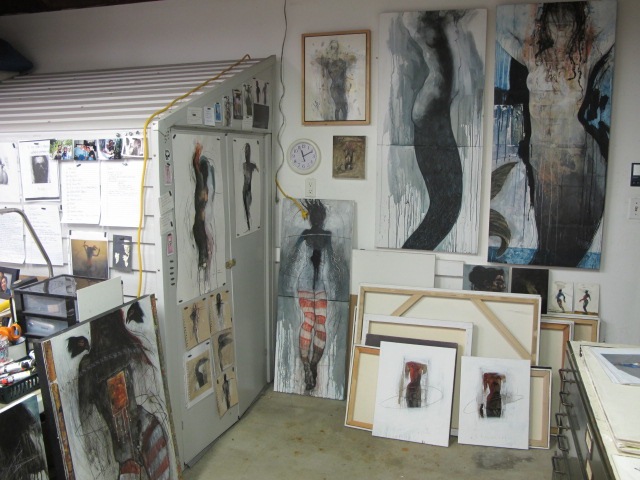
David: No, I can't. I'm all over the place. I've got to have at least three or four things going on at once, because I work in very short, intense bursts. And I'm very aggressive when I work. I have power sanders, and you can see that I've sanded the hell out of this piece because I didn't like what was going on. I will just attack a piece, and I will just beat the hell out of it. And then I have to get away from it. Then I'll focus on something else. And nine times out of ten I'll be working on that other piece and it will solve the problem of the piece I was just working on. I call it cross fertilization. These things start talking to each other. The thing is though, that you have to be careful not to get into what I call the paint by number syndrome, where you mix up a color that you like and you put a little there, and then you say, "Ooh, that would look good on that one, and ooh that would look good on that one, and ooh that would look good..." and then everything starts looking the same. But there's a buzz that starts happening in the studio when they are talking back and forth. And the studio is small, but it's the perfect size for me. I can have everything right here.
Jim Dine is one of my all time favorites, and he said that he puts all this effort into his work, and then, when a piece is finished, the party's over. It has to take care of itself. He moves on. You keep going. Moving forward. Moving forward.
Michael: So who else? Jim Dine...
David: Artists? Well, I love Leonardo Da Vinci's drawings. That's one of my all time favorites.
Michael: I can see that.
David: Yeah, a lot of people say that.
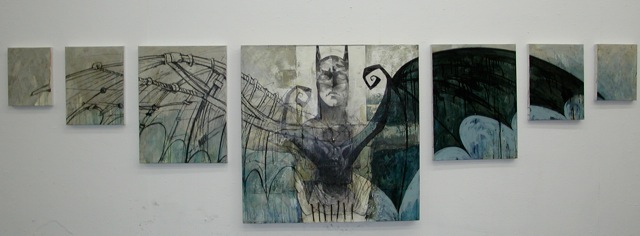
I did a piece sort of in homage to him. It was a self portrait as Batman, as the Dark Knight. I got invited to be in a group show about superheroes and I didn't want to just do a stupid painting. And Batman was always one of my favorites growing up. So I did this piece, fourteen feet long, with a center figure from the waist up, cowl, with my face, a realistic drawing of a bat on the chest, and the wings. The canvases for the wings were separate from the main piece, and gradually smaller. So on one side was a full-on rendered bat wing, and the other side was Leonardo Da Vinci's drawing of a wing.
It still gives me goose bumps when I think about it. I was trying to figure out what to do, and then I remembered that he had designed this wing, so when I thought of it, oh my god, it was perfect!
I also love Edvard Munch—the emotion that comes out of his work.
And Rico Lebrun, who was a local California guy in the 60s. He took figures and sort of turned them inside out, or into animals or bugs. A very interesting guy. Egon Schiele; I love what he did with line. And the abstract expressionists— what Rauschenberg did just kills me. I think it's where some of this stuff comes from. Willem de Kooning, Nathan Oliveira, bay area figurative guy.
Peggy: He taught at Stanford.
David: Yeah. So those are some people that float my boat.
Michael: Any thing you would do differently, if you could go back?
David: Yeah. Be an artist full time and not have to work at anything else. I'd teach still, maybe. But sell enough to just be an artist. That's my favorite thing to do. For me art making is the only place in life that I really feel in control.
I probably would have gotten some schooling on the east coast. I didn't do that. I think that would have been good. I've traveled a little bit, but I probably would travel more. I could still do that. Just to do it I think it would be good to go back for a masters degree.
Michael: Here's the question we always try to wrap up with: What would you tell someone who's just starting out. This could really open things up with what you said earlier about creativity coaching, so take it as far as you want.
David: I will. The first thing that comes to my mind is to not hurry. To not be in a rush to sell and market your work. Be an artist for a while. Hone your craft. Get good. Think about what you are doing—whether you've gone to art school or not. I see a lot of people who are so in a hurry. Especially when I was at Art Center. I mean those kids couldn't wait to get out there and start showing in galleries. And those of us who were teachers would say, "Oh, you guys aren't going to be able to do that." That's the first thing that comes to mind. Don't be in a rush to get out there.
I would also say to try some different things. Don't lock in too soon. Even though you think you are going to be a painter, go take some photographs, or take a sculpture class. Because it's all about seeing anyway. So learn how to see. That's another thing I see. People are just "blindly" making art.
Peggy: That's a great line.
David: Really look. Not only look at what you're painting, but look at what you are doing. I constantly have to tell my students to stand back and look at what they are doing. They stand there for an hour, and throw paint on their painting, and then they stand back and wonder why it's not working. I guess that still goes along with not hurrying. Slow down and learn to see.
One of the things I like about de Kooning, there's a video of him painting. It's a black and white documentary, and I can't remember what it's called. But he's young at the time, and he's in his studio, and there's a painting against the wall. And there's stuff everywhere, and buckets and jars of paint. And there's a path through all this. He's standing well back from his work. Twenty feet, maybe. He's got a brush in his hand, and he's smoking, and he's looking, and looking, and then you can see that little spark in his eye, and he starts walking toward his painting. And on the way, he reaches down and dips his brush into a color, gets up to his painting and goes BAM. Walks back again, and stands there, looking. And you know, it looks like his paintings are done wildly. But when you see this...
Peggy: So deliberate.
David: I always tell my students, "Don't play chess with your work." And by that I mean don't think 25 moves ahead. Because what they'll do, is they'll say, "So what shall I do now?" And I'll give them some thoughts. And then they'll say, "OK, then what?" Wait a minute. This one thing we're going to do might change the entire piece. And if you're thinking three, four, five moves ahead, then you're making your work up hear, and not out here. [Points to his head, then to a canvas] Because your brain can start and finish a picture without any interruptions. I always tell people to get their ideas out of their head as soon as possible. Don't finish a painting in your head. It's never going to look like that. They say, "It never looks the way I envisioned in my head." You know why? It's because you're painting, you do something and then you step back and look at it, and that suggests something else. But your brain just goes off on the path and finishes it. I think I got off on a major tangent there.
Michael: No, that's what we were looking for.
David: That's what I would tell people. Be present. Be aware. Make your work.
Michael: That was our traditional last question, but I have one more that's connected to it, I guess. It's about surviving. You've talked about when work doesn't sell, and not being in too big a hurry to show, and dealing with rejection. But all of that implies that you're not making any money.
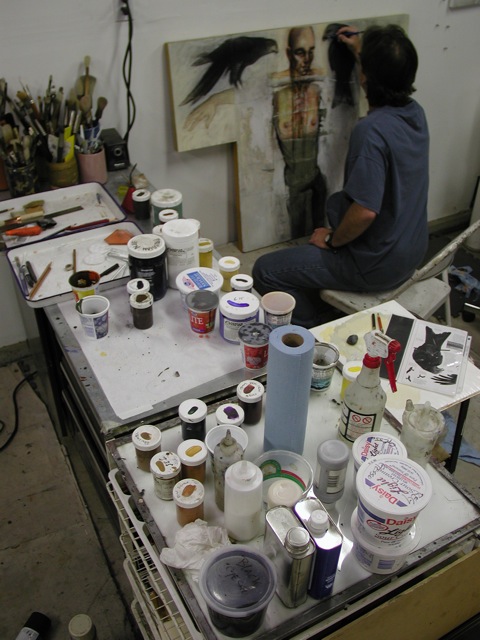
David: Exactly. I've been fortunate in that I've had the teaching jobs. I think if you are committed to a life of art making, you're going to find a way. I'm not interested in the excuses. If it means that you get a desk job, or you're working at Whole Foods, then you're doing it. Very few artists can just make art all day. There are statistics about what percentage of artists can actually make a living from their art work, and it's what—five percent? The rest of us have to find a way. I can say that, and I acknowledge that, but it's out there. And I don't think you should apologize for it. You do what you've got to do. We're all doing what we need to do. It's the art that matters.
Michael: As we're writing every week, I have a tendency to think in terms of how do you get to that point. But maybe you don't.
David: Yeah, maybe not. It would be nice, and I don't think you should ever stop shooting for that. I think it's one of the things that can keep us going, but I think you have to balance that with reality. And the reality is the economy. And not selling work. Most galleries are having a hard time.
Peggy: Well it's clear that you are a fabulous teacher and coach.
David: Thank you. I really enjoy teaching. It really fuels me. I don't think the students really get how much the teacher gets from it. I learn things from them. They've got one teacher, I've got 12 or 15. And I tell them that. That's another lucky thing. You get to put yourself out there, but it comes back.
Michael: That addresses the dynamic of artists sharpening each other.
David: Very much so!
Michael: That's really why we're doing what we're doing.
David: I've only read a few of your interviews so far, but from the few I've read, I've gotten a tremendous amount out of it. I think it's fabulous what you're doing. You know, artists tend to live in a vacuum. Yeah sure, we go to openings and we do this and we do that, but when it really comes down to it, what you're doing is you're opening studios and letting us have this sort of a dialog. Another idea I'd love to get going sometime, and this could be something for Windhook down the line, would be some sort of artists' support group. It could be once a month or whatever. But it could be critiques, it could be guest artists, it could be demonstrations. I don't think that's a new idea. I'm sure other people are doing it. But there are a lot of artists out there that could use that.
Peggy: Absolutely.
Well, this has been great.
Michael: I'm pretty sure we will need to talk more.
| 






 I will let you know when my new site is launched. Work on the new website slowed down a bit when my dad died a couple of months ago, but it's picking up again now. Should be ready to launch in September.
I will let you know when my new site is launched. Work on the new website slowed down a bit when my dad died a couple of months ago, but it's picking up again now. Should be ready to launch in September.
 I don't really know how much they appreciated my work. They were always pretty conservative. But they had some odd things of mine hanging in their house, which always surprised me a little bit. We never talked about the subject matter. The one thing they had in their house is a piece called Grafter. It's a nude woman. I borrowed the pose from a
I don't really know how much they appreciated my work. They were always pretty conservative. But they had some odd things of mine hanging in their house, which always surprised me a little bit. We never talked about the subject matter. The one thing they had in their house is a piece called Grafter. It's a nude woman. I borrowed the pose from a 






